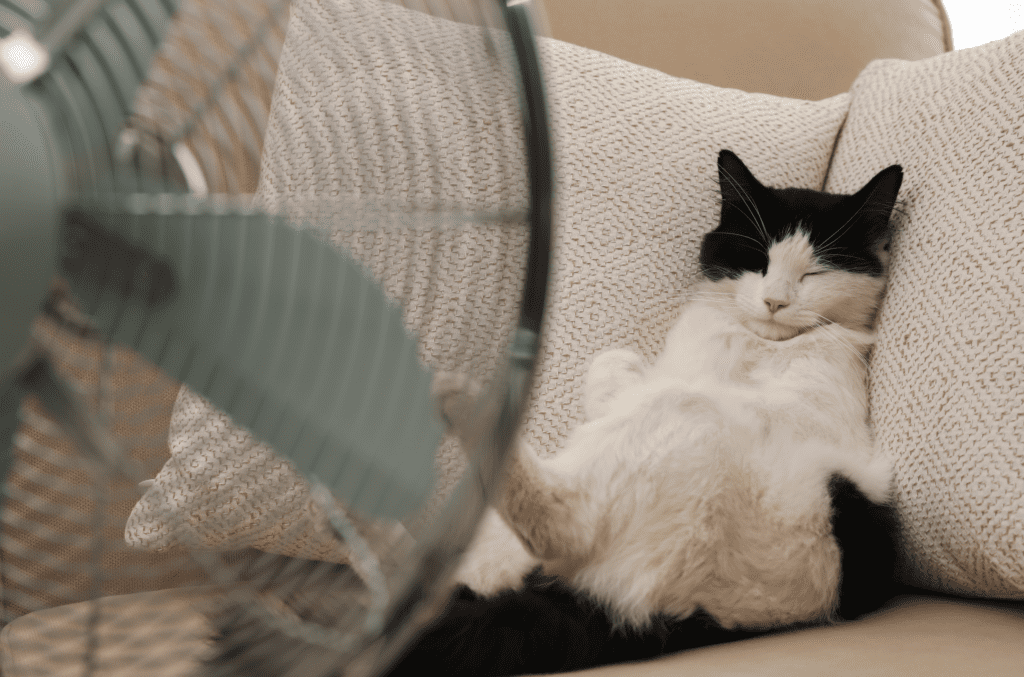Share This Blog With Other Pet Parents!
Protecting Pets from Heat: Summer Pet Safety & Dangers in Queensland
Every pet owner understands the joy of seeing their animal companion frolic in the great outdoors, but many remain unaware of the potential hazards the summer season brings.
From the scorching heat of asphalt to the risk of dehydration, summer presents challenges that can affect both domestic and exotic pets alike. Delve into this guide to uncover essential summer pet safety tips, ensuring that while you enjoy the sunshine, your pet remains protected.
What you’ll learn from this blog:

For all you need to know, download our
FREE Dental Guide
This blog is part of our Proactive Pet Parent series! This is just the beginning… To see more blogs, click here! Better yet, sign-up to our newsletter to receive these directly to your inbox each month.
Sign-up To The Proactive Pet Parent Newsletter
Heat and Dehydration in Pets
With summer temperatures in Queensland often exceeding the comfort zone, the scorching heat isn’t just an inconvenience; it’s a genuine health concern, especially for our pets. Unlike humans, most pets have a limited ability to sweat, making them particularly vulnerable to overheating. These conditions can escalate to life-threatening levels in mere moments.
A simple act such as leaving your pet in the car might seem harmless for a few minutes, but with temperatures soaring, this could quickly turn disastrous. Even with windows partially open, the temperature inside a parked vehicle (even in the shade) on a hot day, can rise to dangerous levels. This rapid rise can lead to heat stroke, a condition where a pet’s internal temperature spikes, causing potential organ damage or even death.
Dehydration, too, is an ever-present threat. The signs: sunken eyes, lethargy, and a dry mouth—can be subtle but are clear indicators that a pet isn’t getting the necessary hydration. It’s essential to remember that the standard water bowl might not suffice during hotter days. Frequent refilling and ensuring constant access to fresh, cool water becomes even more critical.
While outdoor activities might seem tempting, it’s advisable to time them during cooler parts of the day—early morning or late evening. The midday sun not only intensifies the heat but also increases the risk of burnt paws from hot pavements. Simple measures, such as walking on the grass or testing the pavement’s temperature with the back of your hand, can make a significant difference.
Ultimately, understanding these hazards and adapting our routines can make all the difference. By being proactive and prioritising our pet’s needs, we can guarantee a safer summer experience for them.

Hot Asphalt and Paw Burns
One often-overlooked danger during these warmer months is the burning heat of asphalt and concrete. These surfaces absorb heat rapidly and can become hot enough to fry an egg – or, more relevantly, cause serious burns to the delicate pads of our pets’ paws. Within mere moments of contact with such heated surfaces, pets can suffer from painful burns, leading to blisters, cracks, or even more severe injuries.
The five-second rule can be a lifesaver: place the back of your hand on the pavement, and if it’s too hot to hold for five seconds, it’s a no-go for a walk. There are also protective measures available, such as pet-friendly booties that act as a barrier between the scorching ground and your pet’s sensitive paws.
Additionally, consider alternative walking paths. Opt for grassy routes, shaded areas, or even waterside walks where the ground is naturally cooler. Regular paw checks can also be beneficial, ensuring any minor injuries are detected and treated promptly. The sizzling streets of summer may pose a threat, but with awareness and simple precautions, it’s entirely possible to safeguard our pets from the burning grip of hot asphalt.
Summer Toxins and Hazards for Pets
Summer brings a medley of plants, foods, and chemicals into our environments that, while harmless to humans, can pose significant risks to our pets.
The list is extensive, from seemingly benign garden plants like lilies, which are particularly toxic for cats, to the allure of summer fruits such as grapes and currants, which can be perilous if ingested by dogs. Even a casual summer BBQ, while a delight for us, introduces potential threats. Foods like onions, garlic, and even certain artificial sweeteners found in many summer treats can lead to serious health complications for our furry companions.
In addition to edible threats, many summer activities bring along a suite of chemicals that pets might encounter. Pool chemicals, insect repellents, and even certain sunscreens can contain ingredients that are hazardous if ingested or applied to pets. A simple spill or an unsupervised moment can swiftly escalate into an emergency.
Awareness is the primary defence. By being informed about these potential hazards, pet owners can create a summer haven that is both fun and safe. Restrict access to potentially harmful substances, and be proactive in ensuring that any product or plant introduced into your pet’s environment is safe for them. In the event of ingestion, time is often of the essence. Immediate consultation with a veterinarian can make a difference, so having an emergency contact at hand is always a wise precaution.
Summer should be a time of joy, relaxation, and outdoor fun. With an informed approach, it’s entirely feasible to ensure that the season remains a period of sunshine and safety for every family member, including our cherished pets.
Water Safety and Drowning Risks
Contrary to popular belief, not all dogs are natural swimmers. Some breeds struggle in water due to their body structure, while others may simply be unfamiliar or fearful. Cats, on the other hand, are generally not inclined to water at all. Yet, accidental falls into pools or other water bodies can occur. This underscores the need for preventive measures like fencing around pools and constant supervision during any water-based activity.
Even for pets that revel in water, there are hidden challenges. Strong currents in rivers or oceans can swiftly sweep away even the most adept swimmers. Lakes, often appearing serene, can have unexpected drop-offs or concealed obstacles, leading to potential entrapment or injury.
Another overlooked aspect is the quality of water. Stagnant ponds or lakes might host harmful bacteria or algae that can cause illnesses when ingested. Similarly, chlorinated pool water, if consumed in large amounts, can upset a pet’s stomach.
The message is clear: vigilance is paramount. Equip your pets with life vests when venturing into deeper waters. Introduce them gradually to any water source, ensuring they’re comfortable and familiar with the surroundings. Keep fresh drinking water handy to deter them from consuming potentially harmful water from pools or natural sources. And most importantly, never leave them unattended near water, even if it’s just for a moment.
Protecting Exotic Pets
From reptiles to birds, the unique requirements of these special creatures often differ considerably from those of cats and dogs. It’s essential to understand and cater to these unique needs, ensuring they stay healthy and comfortable during the hotter months.
Reptiles, for instance, often rely on external heat sources for thermoregulation. While it may seem that summer provides ample warmth, direct sunlight can quickly become overwhelming, leading to overheating. Creating shaded areas in enclosures, monitoring temperature fluctuations, and ensuring that basking spots don’t become too hot are all vital. On the flip side, reptiles also need a cooler spot to retreat to, helping them regulate their body temperature effectively.
Birds, with their delicate respiratory systems, can suffer when temperatures spike. Direct exposure to sunlight, especially if confined within a cage, can become lethal. Ensuring that their habitats remain shaded, offering misting or bathing opportunities, and guaranteeing ample airflow are critical components of bird care in the summer. Additionally, just like dogs and cats, birds need continuous access to fresh water, both for drinking and cooling.
For smaller mammals like guinea pigs, ferrets, or rabbits, overheating is a significant concern. These creatures don’t sweat like humans, relying on other means to cool down. Keeping their enclosures in cooler areas of the house, providing frozen water bottles for them to lie against, and frequent checks for signs of distress can make a world of difference.
Heat Stroke in Pets: Signs and Prevention
Summer in Queensland can be particularly unforgiving, and with soaring temperatures, the risk of heat stroke in pets rises dramatically. Heat stroke is a severe condition where the body overheats and can’t cool down, leading to potential organ damage or even death. As responsible pet owners, it’s crucial to recognise the early signs of heatstroke and know how to prevent it.
The initial signs might seem subtle: excessive panting, drooling, and lethargy. As the condition progresses, a pet may show signs of dizziness, rapid heartbeat, vomiting, or diarrhoea. Dark or bright red gums and tongue, staggered walking, or even sudden collapse are indicators of an acute emergency.
Prevention, as always, is the best form of protection. Here are some methods:
- Consistent Hydration: Always ensure that pets have access to fresh and cool water. Keeping multiple bowls filled, especially when outdoors, is a good practice.
- Limit Sun Exposure: During peak hours, between 10 am and 4 pm, try to keep pets indoors or in shaded areas. Morning and evening walks are best for dogs.
- Ventilation: If pets are outside in an enclosure or even inside the house, ensure there’s ample airflow to help them cool down.
- Cooling Tools: Consider using pet cooling mats, fans, or even misting systems to help regulate their temperature.
- Acclimatisation: If you have a pet that’s new to the Queensland climate, give them time to adjust. Gradual exposure can help them acclimatise better.
- Regular Check-ups: Regular vet visits can help detect any underlying conditions that might make your pet more susceptible to heat-related issues.
By remaining vigilant, understanding the signs of heatstroke, and taking preventive measures, it’s entirely possible to ensure our pets remain safe and enjoy the warmer months alongside us. Remember, immediate action is vital if you suspect heatstroke. Cooling your pet down gradually and seeking veterinary assistance right away can be the difference between life and death.


